In the wake of shooting events which received a lot of publicity, several people asked me about the best way to act should in an active shooter situation. In one event, two American service members, vacationing in Europe, subdued a heavily armed suspected terrorist onboard a Paris bound train and averted a catastrophe. In another event, a television reporter and her cameraman in Virginia were brutally murdered on camera by a former co-worker. Sadly, another event took place on December 2, 21015, where husband and wife Syed Rizwan Farook and Tashfeen Malik, in an Islamic-State-inspired attack, entered a holiday party event of the San Bernardino County Department of Public Health, killing 14 and injuring 22. This was in the wake of attacks in Paris on November 13, 2015, in which terrorists killed 130 people and injured 368 in six concurrent attacks around the city.
The events serve as a good reminder to train ourselves, mentally and physically, to deal with what to do when someone is shooting at you. Taking a few minutes to read and prepare for this situation can make a huge difference if, god forbid, you find yourself in an active shooter situation.
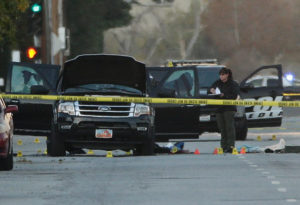
“Luck?” Drizzt replied. “Perhaps. But more often, I dare to say, luck is simply the advantage a true warrior gains in executing the correct course of action.” ― R.A. Salvatore, The Halfling’s Gem
The FBI defines “Active Shooter” as an individual or group of individuals who are “actively engaged in killing or attempting to kill people in a confined and populated area.” Since active shooter situations are unpredictable and evolve quickly, it is a good idea to be prepared to deal with them before law enforcement personnel arrive on the scene. The purpose of this article is to help you be prepared.

Dealing with an Active Shooter
As with most self defense situations, the best way to deal with an active shooter is to avoid the situation. In our Carmel Valley martial arts and self defense classes, we teach personal safety framework consisting of four stages, and which works well in armed situations:
- Avoid the situation – this, of course, if the most preferred approach
- Escape the situation – if you failed at avoidance, make for a quick escape (more about this later)
- De-escalate – note that this can be quite difficult in an active shooter situation
- Fight – if all of the above fail, be prepared to fight (more about this later). It is a self defense myth that empty handed, you cannot prevail against an armed opponent!
We will get into those in just a moment. But first, let’s make a few important distinctions.
Armed Robbery and Active Shooter Situations
Facing an armed robber who is after your belongings – wallet, watch, jewelry, car, etc. – is not an active shooter situation. My best advice is that no physical object is worth the risk of dying. A far better approach is to comply with the armed robber, give then what they want, and move on with your life. Do not let your ego get in the way, and turn a “business” transaction into an active shooter situation!
For a fascinating read, check out the testimony of a teenage mugger, explaining on the witness stand why he chose to shoot New York actress Nicole duFresne when, in defiance of his requests during a mugging she said, in a tone filled with disdain: “What are you going to do, you going to shoot us?”. The mugger got so mad that shooting is exactly what he did. Nicole died on the spot.
You don’t want to be in that situation. When confronted with a gun you will be flooded with emotions. You need to mentally prepare to rise above those and treat the situation as it is – a business transaction.
If you have practiced this, you can also use your voice, calming tone, and measured speech, to de-escalate and calm the perpetrator down, further reducing the chances of an intentional or unintentional discharge.
Gang (and other) Warfare and Active Shooter Situations
Gang warfare is also distinct from active shooter situations. The participants in gang or other warfare are usually intent on killing someone specific, such as a member of a rivaling gang. While they may not take much care to minimize collateral damage on the ordinary citizens, they are not specifically there to shoot you.
In addition to avoidance (for example, of areas of town known for gang activities), the same approach that applies to active shooters, and which I describe below, will work well if you are caught in the crosshairs of a gang fight.
A few words about Guns and Shots
There are many different types of guns and ammunition. Some rudimentary understanding of those is helpful for self defense.
Most people are fairly bad shots. While at a distance of 6 feet, even an untrained person armed with a handgun can shoot and hit an opponent, as distances grow (and given the adrenaline of the situation), accuracy of all but the best trained shooters falls precipitously. For example, the Force Science Institute found that trained police officers, in a “sterile” shooting range setting, were only able to hit 38% of their shots to a target in the 18 to 45 feet distance!!!
All this goes to say that just because a gunman is shooting at you does not mean that you will be hit. Making yourself small, moving away, and pressuring the shooter are all strategies that greatly increase your chances of survival. We talk about those in detail.
Concealment and Cover
Unlike a punch thrown by a bully, a bullet, once discharged, will continue to fly until it either runs out of energy and falls to the ground, or hits something. The figure below shows several gun types and ammunition common in active shooter situations, and their penetration power: shotguns, handguns, assault rifles and sniper rifles.
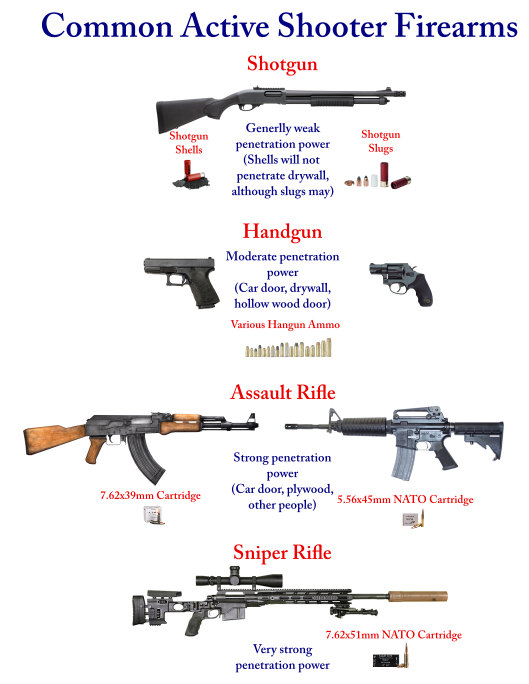
In tactical theory, we differentiate between objects that provide concealment, i.e., visually hide us from the shooter, and objects that not only hide us but also provide solid protection from shots fired at us. The two figures below demonstrate those.
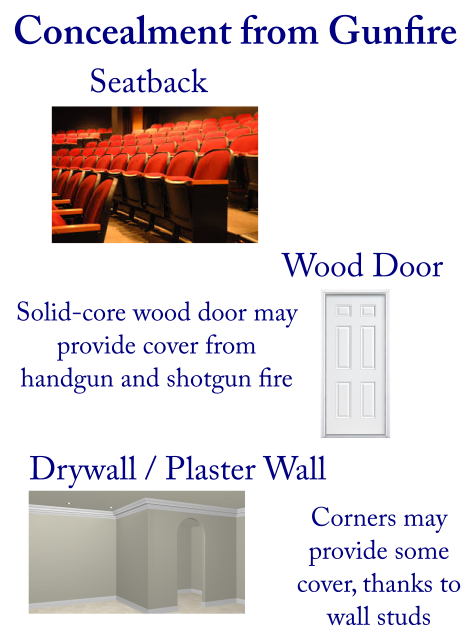
Of course, the type of gun and ammunition used will make a difference on whether an object provides good cover or not. Consider the following:
- The drywall material commonly used for internal walls in your home or office will not provide cover from most shots (shotgun shells being one of the only exceptions).
- The stucco exterior wall of your home or office may provide cover from some lower powered handguns, but will definitely not stop shots fired from assault rifles.
- Likewise, a solid-core wood door may provide cover from some lower energy bullets, but not from high energy shots. A hollow-core wood door will not provide cover at all.
An important point about cars: while the doors of your car provide poor cover from gunfire, hiding in a way that places the engine compartment between you and the shooter will provide for excellent cover even against high caliber high energy shots.
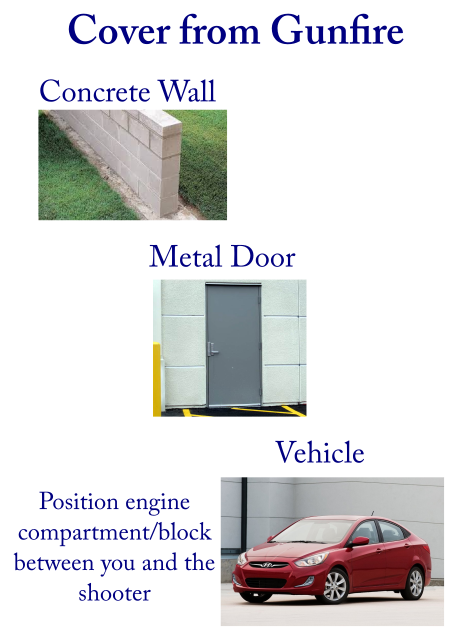
Be Aware of your Surroundings
Adopting a safety mindset is a great asset for your personal security. When you get into a new place, take a quick scan and note to yourself the escape routes. Also note what objects can be used for cover and for concealment.
Note that in an emergency a window can also be used as an exit. (If needed, use a chair or other hard object to break the glass.)
Should an emergency (even a fire) emerge, you will be in a good position to immediately react.
Avoiding Active Shooter Situations
The best path to being safe is avoiding active shooter situations. Homicide at the workplace is very rare. According to the FBI, there are less than 0.01 incidents per 1000 persons in the workplace.
Perpetrators of workplace or school violence sometimes give warning signals before embarking on a deadly rampage. Those can be overt, or covert. Stalking and verbal or written threats are obvious red flags, as are the following types of behaviors in colleagues:
- Paranoid ideas
- Delusional statements
- Increased isolation
- Changes in personality or performance
- Depressed mood
- Suicidal intent
- “Odd” or “bizarre” behavior
- Some of the above, combined with an interest in acquiring a firearm
Trust your instincts – if something does not feel right, leave and report to the authorities.
Escaping Active Shooter Situations
If you are caught in an active shooter situation, putting a lot of distance between you and situation quickly is your best courses of action. As a private citizen, you are not required to confront or take down a gunman, and engaging the gunman (even if you are armed) will most definitely draw the gunman’s attention and his fire to you.
Where to escape? Away from the gunman. The Kill Zone is the area ahead of the shooter’s barrel, spanning a few degrees right and left, up and down. The kill zone is where you do not want to be. Everyone knows that no one can out-run a bullet, and therefore you should escape sideways, or even better, escape behind the active shooter’s direction of travel.
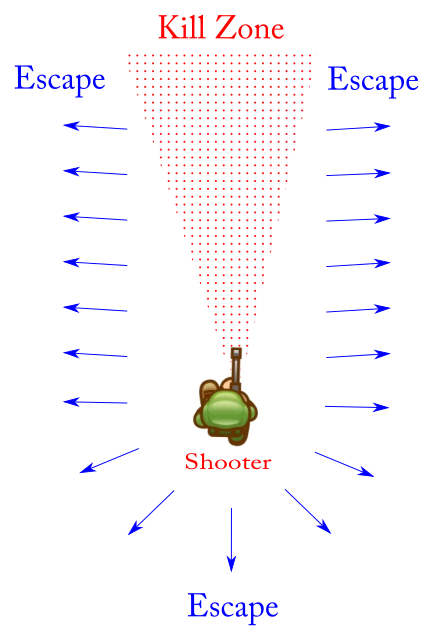
Additional tips on escaping:
- As you escape, take advantage of cover and concealment, and keep going! The more distance between you and the gunman, the better! Get behind a parked car or bookcase, and keep running!
- Run in a crouched position, to make for a smaller target.
- If you are the specific target of the gunman (perhaps a disgruntled co-worker), you will have to work much harder to escape. Expect to be pursued. Use the terrain to your advantage (see the next section).
Active shooter situations are dynamic, and a shooter who is advancing in one direction may later turn around. This is why your objective should be to put as much distance between you and shooter ASAP.
Open Space vs. Closed Space
In an open space such as a park, there are many directions in which to escape. This may not be the case in a closed space such as an office building, school or a movie theater. Buildings have many obstacles that hamper escape. There are walls, doors, furniture, etc. Remember that when escaping, you can make your own route. Do not hesitate to break windows (use a chair or fire extinguisher), jump over furniture, knock down cubicle walls, etc. and, of course, utilize fire escape routes. If you are able to create barriers that would slow down the active shooter as you escape, that’s even better!
A long hallway in a building presents a special problem. This is because you cannot escape to the right or left, and are forced to run straight down the hallway. In this case, running in a crouched position, and in a zigzag pattern will make you a much more difficult target to hit.
Use the environment around you to your advantage! If you are outside, and are being pursued by a gunman, run into buildings, and out the other side. If you are inside a building, run outside. If you are the sole target of the gunman, run toward crowded and well lighted places.
Once Escaped – Report
Once you have escaped the danger, alert law enforcement by calling 911. Calm down, breath, and work to relay as clear and accurate information as possible:
- How many suspects are there?
- Where is/are the suspect(s)?
- Have they left the scene?
- What are they wearing (including body armor)?
- Where are they moving toward?
- What types of weapon(s) are involved?
- How many shots have been fired?
- When was the last time you heard gunfire?
- Where are you located?
- How many people are with you?
- How many casualties?
- Are there hostages?
The more accurate you can be, the more you are to first responders!
When it is Not Possible to Escape
In a crowded movie theater, or cornered in an office, it may not be possible to escape the immediate surrounding. In such a case, utilize concealment and cover. Lie down behind furniture, theater seatbacks, and other obstacles. Cover your head with your arms, to protect it from shrapnel. When you are able to escape, do so!
In Close Range – FIGHT!
In close range, it may not be able to escape or to hide. In this case, you must fight.
It is a myth that it is futile to fight an armed person when you are unarmed. The American vacationers on the France bound train are but one example of unarmed citizens successfully thwarting armed gunman.
Beyond all – ACT!! It is quite common for people to freeze under attack (“deer in the headlights”). With training and mental preparation you can force yourself to overcome the “freeze.” Develop your warrior mentality of continuing to fight and struggle until you have an opportunity to escape.
It is also a myth that you must have lots of training to prevail against a gunman. While training will surely help, you can and should act even if you are not trained. (We discuss some gun takeaways techniques here.) Remember, the active shooter would rather have bullets going only one way, once you pressure the active shooter and expose them to danger – from flying furniture, fists or whatever “goodies” you are giving them – they will surely slow down. Their weapon may jam, they may lose their aim, and they may panic – all good things for you. Shooting a paper target at a sterile range, and shooting a person who is actively fighting with you are two completely separate things!
If you are empty handed, and you must fight, remember that close range is your friend. The closer you can get to the active shooter, the better you can neutralize the gunman’s advantage of holding a firearm. Use the environment to your advantage – you can throw chairs, utilize fire extinguishers, shove furniture. Once you close the distance, control the weapon, hit, and continue hitting. If I may be forgiven for the plug, Okinawan karate train specifically in this intimate range, and can be of great help.
If you Get Shot
It goes without saying that, as you attempt to escape, and especially in actively fighting the gunman, you may get shot.
What happens to you if you get hit by a shot largely depends on your expectation. If you expect that you will fall to the ground after the first shot, you will.
While it is true that some shots can be fatal, many shots will inflict damage, but will not kill you. You will be able to continue and fight / escape.
The mindset is simple:
So long as you can keep moving, do so! Keep fighting. Keep escaping.
The case of the shooting of the reporter and cameraman in Virginia demonstrates this clearly. The subject of their interview, Vicki Gardner, got shot in her back. Although she initially curled in a ball, she was later able to walk to the ambulance on her own cognizance, and in spite of severe damage to her internal organs.
When Danger Passes
When danger passes, pat yourself down, and check for damage. Do not rely on your feeling, as adrenaline does wonders to our ability to keep going in spite of being injured.
Report (see above section) and seek help.
Examining Two Shooting Events from a Tactical Perspective
It is worthwhile to examine the two shooting events in Europe and in Virginia from a tactical perspective, and see what we can learn.
I will start by saying that any event where people are hurt or lives are lost is a tragic event. My heart goes out to the victims and their families. In offering the below, it is not my intent to play “armchair advisor” and offer advice on “how things could have or should have been done.” The below is simply intended to be a factual description of the events, based on collection of accounts reported in the press.
In first event, on Friday, August 21, 2015, the heroic efforts of two Americans on board a train bound from Belgium to France thwarted an active shooter. Alek Skarlatos, a specialist in the National Guard from Oregon, who has just returned from deployment to Afghanistan, and Spencer Stone, Air Force Airman First Class (and a martial arts enthusiast) were vacationing in Europe with a friend. As the train on which they were traveling was crossing over the border to France, they heard someone loading a gun in the train’s restroom. Taking decisive action, they opted to confront the gunman, Ayoub el-Qahzzani. The gunman fired on them with his handgun, and wounded one of them. They continued to fight, tackled him, disarmed him of his handgun, and tried to shoot back. As the gun jammed they continued to fight to subdue the gunman. In the ensuing struggle, the gunman was able to pull a knife and slice one of them. They continuing to persist and fight, eventually overcoming the gunman. There is no telling of the extent of the catastrophe had the gunman not been thwarted.
Just a few days later, on Wednesday, August 26 in Smith Mountain Lake, Virginia, grave events unfolded in the early morning. Vester Flanagan , a former employee of local TV station WDBJ shot and killed, on camera, WDBJ cameraman Adam Ward. After watching the gunman fire the initial shots and miss, then hit her cameraman, reporter Alison Parker attempted to run away. The gunman continued to shoot at her and miss, until finally hitting her. As the shots started, the interviewee, Vicki Gardner, curled in a ball and lay on the floor. She received a shot to the back, which hit her kidney and colon. After the gunman left and law enforcement arrived, Mrs. Gardner was able to walk to ambulance on her cognizance.

In Conclusion
Having the right mindset, what we call in martial arts a “warrior mindset” greatly enhances your odds of surviving an active shooter event. A warrior mindset starts with awareness – being aware of your environment and of people in your environment and their behavior patterns. A warrior mindset continues with dogged persistence in taking action, be it escaping the active shooter situation or, if that is not possible, engaging and fighting the shooter.

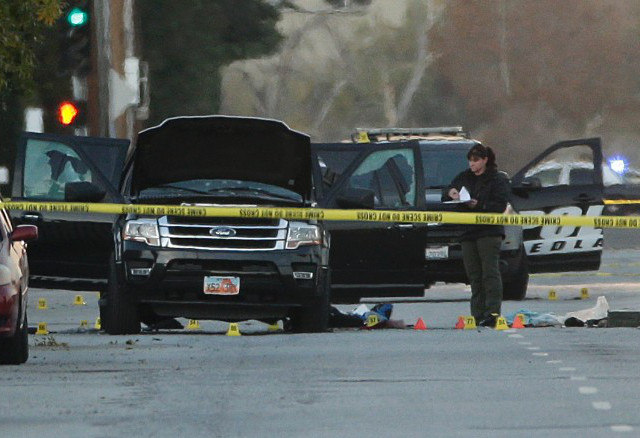
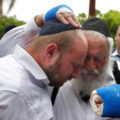
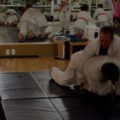
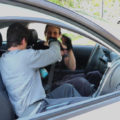
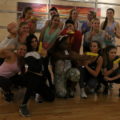
The fact that you quoted Robert Salvatore’s character, Drizzt, makes this post that much more awesome!
The best way to defend yourself from an active shooter is to be aware, carry a gun, and train until you can effectively shoot your attacker in the face under duress. Karate is great, and I train daily, but if you identify as a warrior and fail to arm yourself, then you get what you get.
Of course of tremendous advantage to be armed with a gun. However, sometimes we don’t have that choice. Many states and countries have very strict gun ownership and/or gun carry laws. Also, when we travel to another country we rarely if ever can be armed.
The good news is that even without a gun there is a lot that we can do to keep ourselves safe from an active shooter. The purpose of this article is to provide knowledge and advice for that situation.
Of course, the best way to ingrain knowledge is through training. The US Marine Corps, cops is your police department, pilots, firefighters, etc. do not simply jump into action — they train repeatedly, both initially and recurrently. The same is true for gun skills. Owning a gun without constant and recurrent training will create a false sense of security, and very unpleasant surprises should the need to use it arise. Likewise, to stay current on the active shooter protection techniques discussed in this article, training and rehearsing is highly recommended!
Best of luck!
Brian
Very Resourceful
This is in need of an update. We need more actionable “shootee” training in light of the events in LV.
Hi Maisha,
If you are serious about active shooter training I would highly recommend taking respectful self protection training.
Practical training is key in developing a skill — especially a skill you want to draw upon when under extreme duress.
Specifically, the Las Vegas shooting are extremely sad and unfortunate. The situation where an active shooter is firing from above and into a crowd is a difficult situation. This is for two reasons:
1. The oblique angle of fire means that fewer covers are available. In those angles you literally need to get “under” a cover, as many covers that work well for fire from your elevation don’t work when the fire is coming from above.
2. The crowd around you means that it is difficult to escape. The crowd also creates additional challenges and risks, e.g., a stampede that can result form panic setting into a crowd.
There are specific skills that you can train for these situations, and those can be done in a class.
In those tough times be afraid or even paranoid of future attacks. This is the wrong approach.
The reason we train in developing solid self protection skills is not because we are paranoid.
Rather, it is because we want to be confident in our ability to act in difficult situation so we can enjoy life!
All the best,